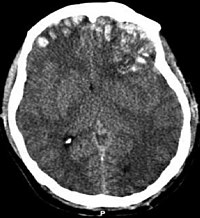
Photo from wikipedia
ABSTRACT Purpose To determine the characteristics and epidemiology of open globe injury (OGI) in a third referral centre over 11 years. Methods The study was a retrospective observational study. The… Click to show full abstract
ABSTRACT Purpose To determine the characteristics and epidemiology of open globe injury (OGI) in a third referral centre over 11 years. Methods The study was a retrospective observational study. The medical records of 978 OGI cases (a total of 998 eyes), admitted to Chiang Mai University Hospital, Thailand from January 2006 to December 2016, were reviewed. Results The mean age (SD) of patients was 39.1 (17.5) years. Patients were predominantly male (867, 88.7%). The age with the highest incidence of injury ranged from 41 to 60 years, in both genders. Most injuries happened at the workplace (64.8%), with flying objects from electric grass trimmers (23.9%) being the major injury-related mechanism. Penetration injuries were found in 479 eyes (48.0%). In elderly group (aged >60 years), a higher proportion of a globe rupture injuries were observed (13.3%). In general, intraocular foreign body group presented with better initial visual acuity (VA) compared to other injury types (p< 0.001). In all types of injury, final VA was significantly improved after treatment. However, rupture and perforation globe injuries had significantly worse final VA outcomes, compared to penetration and intraocular foreign body injuries (p< 0.001). With multivariable regression analysis, poor initial VA (p< 0.001), type of injury (p= 0.028), positive relative afferent pupillary defect (RAPD) (p< 0.001), and endophthalmitis (p< 0.001) were associated with poor visual outcomes. Conclusions Work-related eye injury is a major cause of OGI. Poor initial VA, endophthalmitis, presence of RAPD, and rupture were the predictors for poor final visual outcomes.
Journal Title: Ophthalmic Epidemiology
Year Published: 2020
Link to full text (if available)
Share on Social Media: Sign Up to like & get
recommendations!